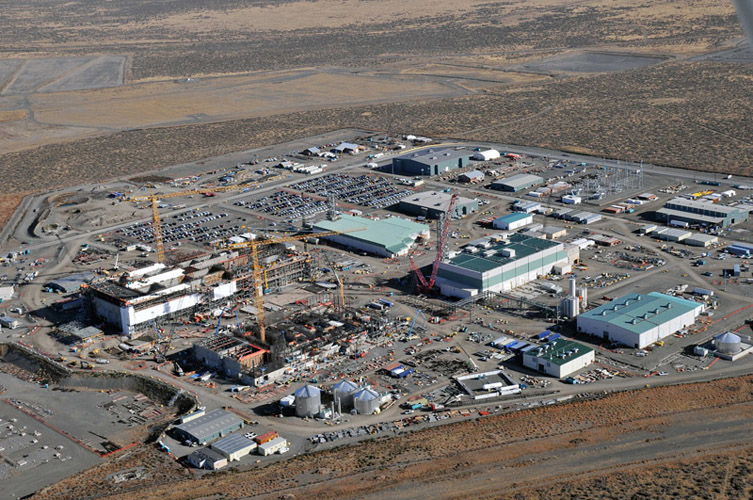A rendering of the BWRX-300 small modular reactor. (Image: GE Hitachi Nuclear Energy)
Wilmington, N.C.–based GE Hitachi Nuclear Energy and Canadian firms Ontario Power Generation, SNC-Lavalin, and Aecon announced this morning the signing of a contract for the deployment of a BWRX-300 small modular reactor at OPG’s Darlington nuclear site in Canada. According to the announcement, it is the first commercial contract for a grid-scale SMR in North America.
Nicholas Hawker of First Light Fusion and Ian Chapman of UKAEA. (Photo: UKAEA)
Ignition and net gain at Lawrence Livermore National Laboratory’s National Ignition Facility (NIF) in December 2022 focused global attention on the prospects of inertial fusion energy (IFE). First Light Fusion and the U.K. Atomic Energy Authority (UKAEA) acknowledged the achievement as they announced plans on January 25 to design and build a demonstration facility known as Machine 4 at UKAEA’s Culham Campus in Oxford, U.K., using First Light’s “projectile approach” to IFE. Construction is expected to begin in 2024, and operations are “likely to commence” in 2027.
The Diablo Canyon nuclear power plant.
The U.S. Nuclear Regulatory Commission announced January 24 that it will not resume its review of Pacific Gas & Electric’s withdrawn Diablo Canyon license renewal application. This decision is a new setback in the long-running effort to extend the life of the plant.
The ICP buried waste retrieval team successfully completed targeted TRU waste retrieval at the INL Site. The effort spanned 17 years and resulted in the exhumation of more than 10,000 cubic meters of buried TRU waste from 5.69 acres of the site’s Subsurface Disposal Area. (Photo: DOE)
The Department of Energy recently honored eight teams from its Office of Environmental Management (EM) with Secretary of Energy 2022 Achievement Awards. The awards recognized projects at the DOE’s Idaho, Savannah River, and Hanford sites, as well as a group of employees that revamped and expanded DOE-EM’s Minority Serving Institutions Partnership Program (MSIPP-EM). In addition, DOE-EM employees on crosscutting departmental teams received awards.
The awards were part of the DOE’s annual Honor Awards, the agency’s highest form of employee recognition for excellence and achievement.
Industry professionals visit INL as part of a U.S. Nuclear Industry Council Conference. (Photo: INL)
The Department of Energy’s commitment to breaking down market barriers with initiatives, programs, and access to facilities is making it simpler and more efficient than ever for industry to partner with national laboratories. It is especially timely, as the country continues to face evolving security, economic, and clean energy challenges. Partnering opportunities via the DOE’s Cooperative Research and Development Agreements (CRADAs) and Strategic Partnership Projects (SPPs) are particularly prevalent in the commercial nuclear community and have seen a tremendous amount of funding and support dedicated to advancing the development, demonstration, and deployment of new reactor technologies.
Artist’s concept of the DRACO spacecraft, which will demonstrate a nuclear thermal rocket engine. (Image: DARPA)
NASA and the Defense Advanced Research Projects Agency (DARPA) have announced they will collaborate on plans to launch and test DARPA’s Demonstration Rocket for Agile Cislunar Operations (DRACO). DARPA has already worked with private companies on the baseline design for a fission reactor and rocket engine—and the spacecraft that will serve as an in-orbit test stand—and has solicited proposals for the next phase of work. Now NASA is climbing on board, deepening its existing ties to DRACO’s work in nuclear thermal propulsion (NTP) technology—an “enabling capability” required for NASA to meet its Moon to Mars Objectives and send crewed missions to Mars. NASA and DARPA representatives announced the development at the American Institute of Aeronautics and Astronautics SciTech Forum in National Harbor, Md., on January 24.
Hanford’s Waste Treatment and Immobilization Plant. (Photo: DOE)
The Department of Energy is asking for feedback on a new report analyzing potential options for preparing high-level radioactive waste for vitrification at the department’s Hanford Site near Richland, Wash. Vitrification is the process of treating radioactive waste by immobilizing it in glass.
The report, Waste Treatment and Immobilization Plant High-Level Waste Treatment: Analysis of Alternatives, was commissioned in response to a 2018 determination by the U.S. Army Corps of Engineers that it was unlikely the DOE would meet its mandated deadlines for treating Hanford’s tank waste.
NIF in winter (Photo: LLNL)
“Star Power” is the name 60 Minutes producers gave their interpretation of the recent experiment at the National Ignition Facility (NIF) that achieved fusion ignition and net gain. Views from inside Lawrence Livermore National Laboratory captured by TV cameras and aired Sunday, January 15—of some of NIF’s 192 lasers, banks of capacitors, target assembly labs, and even the remains of the target assembly blasted in the December 5 breakthrough—are well worth the watch for those of us who are unlikely to visit the site in person.






 In a follow-up to
In a follow-up to 






 The Nuclear Innovation Alliance (NIA) released a new report last week titled
The Nuclear Innovation Alliance (NIA) released a new report last week titled 
